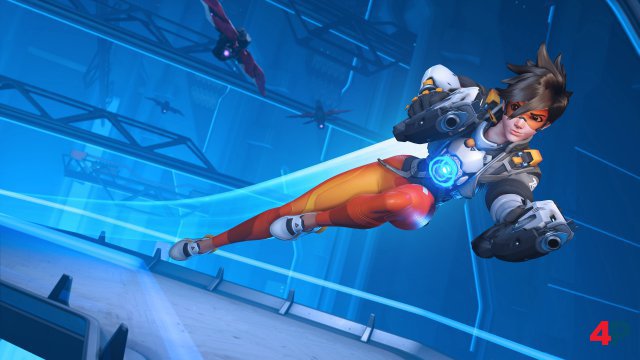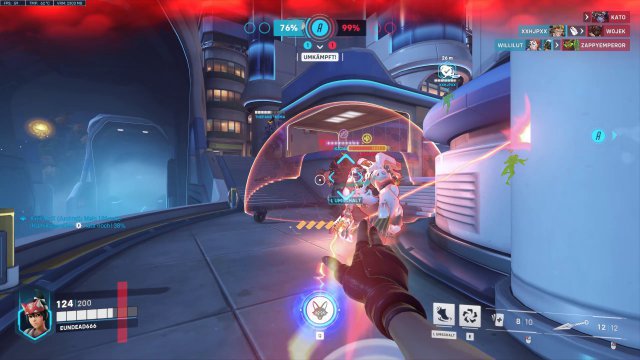Overwatch 2 – review, shooter

A test with obstacles
While the old gentlemen Connemann and Schmid then quickly made up some flimsy excuses (“too old”, “too competitive”, “I still have to test the last Die Sims addon”, “what was a shooter again?”). of the affair, I probably couldn’t throw my Valorant test into the virtual archive poison closet fast enough. Plus I have some experience with 5v5 classics like CS:GO, the distant hero relative of Apex: Legends. And I also spent a few hours in League of Legends. It’s no wonder that responsibility for the test fell into my lap. The problem: I still don’t have any great knowledge about Overwatch, its heroes, tactics, maps and the meta. Sure, you can read it somehow roughly. But a hardcore gamer who has been out and about regularly with Tracer, Mercy and Co. for six years should notice that immediately if just one small detail is wrong.
So I had no choice but to approach the test from the perspective of a complete Overwatch newbie. It’s even quite interesting to see how a new player finds his way into the ecosystem that has grown over the years – after all, Blizzard doesn’t just want old heroes with the switch to a free-to-play model, but above all a new player generation for the still amazingly unique hero shooter. So get into the battles, which have been reduced from six-versus-six to five-versus-five for the second part.
The mother of all hero shooters
But what kind of game is Overwatch 2 anyway? A total of ten heroes face off in two teams on a map on which a mission objective must be completed. In the main modes, sometimes you want to escort cargo to the destination or prevent its arrival, sometimes you want to capture a central point and hold it for a while. There is also a kind of tug-of-war with a robot, in which one team does not attack with cargo and the other defends, but the one who gets their metal colleague pushed into the opponent’s base wins. The heroes are divided into three classes, Tank, Damage Dealer and Support, which fill different roles on the battlefield. Each hero not only has specific weapons, ranging from Soldier 76’s more classic assault rifle to Moira’s magic ray. Each of the 35 characters on the Overwatch 2 roster also has a movement ability and another active ability, plus an ultimate that, with the right timing, can decide the skirmish and maybe even the whole match.
This means that not only does the weapon feel differ significantly when I choose between Ashe with her carbine or Tracer with her Akimbo SMGs, but also in movement. While the nimble Tracer can dash forward three times, Ashe pulls out a sawed-off shotgun and jumps back. There is no normal sprint – and that takes a lot of getting used to if you are used to uniform movement mechanics like Counter-Strike or Valorant. There are also skills such as teleportation, dynamite stick grenades, shields or healing beacons. Also, almost every weapon has a secondary firing mode, from Soldier 76’s rifle’s missiles to Widowmaker’s charged sniper shot. Does the extensive hero roster sound like a lot now? It is! Especially for an Overwatch novice like me who has to navigate the jungle of these possibilities.
basic training? Off to the shark tank!
Because Overwatch 2 is not a clean restart, but seamlessly continues the legacy of its predecessor, which was switched off last week. Including a well-rehearsed community that can make access for newcomers extra difficult. And Blizzard knows that too, trying to slowly introduce new players to the battlefield. This starts with a very simple tutorial and practice arena where I get an extremely brief outline of hero selection and their abilities. Then it’s on to playing against the AI. They teach me everything bot-typical, but definitely not how real opponents behave in the game. The explanations for the battlefield roles in particular are far too short for me – and without my experience from MOBAs and action role-playing games I would probably have been stuck at first. At least short, optional tactical tips apart from the loading screen hints would have been very wise here to make it easier for newcomers to get started.
Good, but there isn’t. So jump into the Unranked Matches, which is the next step on the way to fully unlocking Overwatch 2. I have to play up to 130 games in unranked mode to unlock all the heroes of the predecessor for my account – unless I already own Overwatch, then the roster is open to me from the start. That sounds like superfluous grind at first – but it actually makes it possible to initially adjust to one or two characters per role and then gradually to look a little more beyond the playful box. Because unlike with continuous play, the characters cannot be unlocked, and Blizzard has thankfully avoided a monetization trap here.
Reference-www.4players.de

